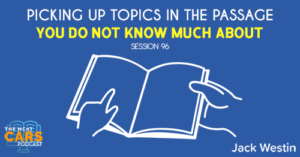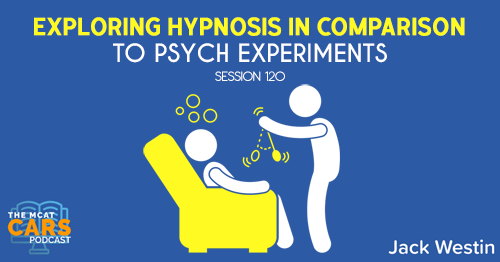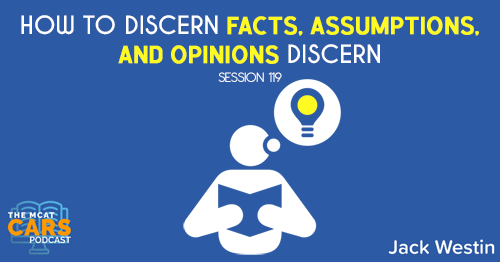Apple Podcasts | Google Podcasts
Session 96
What do you do when you get to a passage that you have no clue what it is talking about? We dive into how to break it down and defeat the passage.
As always, I’m joined by Jack Westin from JackWestin.com. Check out all their amazing free resources including a free trial session of Jack’s full course to see how it’s like learning from Jack Westin himself.
Listen to this podcast episode with the player above, or keep reading for the highlights and takeaway points.
Link to the article:
https://www.theatlantic.com/science/archive/2020/08/accidental-creation-hybrid-fish/614974/
Their mothers were Russian sturgeons—large carnivores with creamy bellies, short, rounded snouts, and green, dragon-like scales. Their fathers were American paddlefish—smooth-skinned filter feeders with sensitive, elongated snouts. “Sturddlefish,” as these hybrids were nicknamed after researchers in Hungary announced their creation last month, go shockingly far beyond classic crossbreeds like mules and ligers, whose parent species sit closely together on the tree of life. Sturddlefish result from the merger of different taxonomic families.
“I’m still confused. My jaw is still on the floor,” said Prosanta Chakrabarty, an ichthyologist at Louisiana State University and the curator of fishes at its Museum of Natural Science. “It’s like if they had a cow and a giraffe make a baby.” Then he quickly corrected himself, because the lineages of those two ruminants split only a few dozen million years ago. The evolutionary paths of paddlefish and sturgeons diverged 184 million years ago. For those fish to breed is more like “if a human came out of a platypus egg,” he said.
Hybrids are often shrugged off as freaky living violations of the rules that keep species distinct. But scientific interest in them has grown with mounting evidence that, in nature, hybrids can be important both in the emergence of new species and in the conservation of species on the brink of extinction.
Yet the new sturddlefish are so radical that they’re shaking up scientists’ understanding of what kinds of hybrids may be possible and which species might interbreed successfully. Studies of the new fish could also provide deep insights into how genomes work more generally.
The successful hybridization of these sturgeons and paddlefish was unintentional, but it wasn’t precisely an accident. In fact, the researchers were counting on the cross to fail so that they could learn something about how sex is determined in Russian sturgeons.
[02:02] MCAT CARS Tips
You have to come into these passages with some excitement around that so you don’t get caught in this kind of mindset of CARS being boring. Students just want to get it over with because they don’t want to do this. And if you don’t want to do this, stop right now.
'Part of medicine is about learning things you don't really want to learn about.'Click To TweetThere are two types of people out there: the people that wait for the rainstorm to pass and the people who learn to love to dance in the rain. So just dance in the rain and just enjoy this. Don’t just try to get through it. Enjoy it and just try to take as much as you can from it.
When you’re done with medical school and residency and you become an attending, you’re still going to have continued education. This is an intensive education where you can really mature and learn about yourself and about things you probably would never otherwise study. It’s a great opportunity to become more open-minded, more cultured that reading, in general, is always a great idea.
[04:06] Paragraph 1, Sentence 1
Their mothers were Russian sturgeons—large carnivores with creamy bellies, short, rounded snouts, and green, dragon-like scales.
Jack says:
You might not know what a sturgeon is, but you know we’re not talking about humans here because they’re saying short, rounded snouts. Could it be a pig? We still don’t know at this point.
[04:57] Paragraph 1, Sentence 2
Their fathers were American paddlefish—smooth-skinned filter feeders with sensitive, elongated snouts.
Jack says:
Maybe we are on this fish route so we have mothers who are Russian surgeons, fathers who are American paddlefish, and then some details about what a paddlefish looks like.
[05:50] Paragraph 1, Sentence 3
“Sturddlefish,” as these hybrids were nicknamed after researchers in Hungary announced their creation last month, go shockingly far beyond classic crossbreeds like mules and ligers, whose parent species sit closely together on the tree of life.
Jack says:
The author here is talking about this hybrid. We do hybrids like mules and ligers. But this is different because apparently this these two fish aren’t very related. So when it says, “whose parent species sit closely together,” we can probably assume that Sturddlefish fish have parents that don’t sit closely together because it’s shocking.
[06:59] Paragraph 1, Sentence 4
Sturddlefish result from the merger of different taxonomic families.
Jack says:
The author is spelling it out for us different taxonomic families and that there are different taxonomic families that are beyond classic crossbreeds.
[07:48] Paragraph 2, Sentence 1
“I’m still confused. My jaw is still on the floor,” said Prosanta Chakrabarty, an ichthyologist at Louisiana State University and the curator of fishes at its Museum of Natural Science.
Jack says:
Now, we have an expert weighing in saying this isn’t normal. And you don’t need to know what ichthyologist is. It’s not that important. But it is probably someone who studies fish.
[08:51] Paragraph 2, Sentence 2
“It’s like if they had a cow and a giraffe make a baby.”
Jack says:
So there’s a good representation here. A lot of students may wonder why there’s no fish. Why is that so different? And then a cow and a giraffe. That’s the power of an analogy when you have the same idea in a new context. So the idea is that we have a shocking hybrid or crossbreed. So here, they’re changing the context to maybe something you’re more familiar with grass and elephants or grass and cows.
[09:39] Paragraph 2, Sentence 3
Then he quickly corrected himself, because the lineages of those two ruminants split only a few dozen million years ago.
Jack says:
The author here is saying that this analogy of a cow and giraffe maybe isn’t appropriate because they’re still closer in lineage than the Sturddlefish parents are. It’s not recent at all, at least for our sake. But in terms of evolution, it probably is.
[10:21] Paragraph 2, Sentence 4
The evolutionary paths of paddlefish and sturgeons diverged 184 million years ago.
Jack says:
It’s amazing how science can guesstimate when things like that happen, just based on looking at the DNA. So we have cows and giraffes a few dozen million years ago, say 36 million years ago, versus 184 million years ago. So that’s a big difference there. The author’s hoping that when they present this information, it again captures your attention. It makes you aware of how crazy this is even though you may not know a lot about this field.
[11:24] Paragraph 2, Sentence 5
For those fish to breed is more like “if a human came out of a platypus egg,” he said.
Jack says:
There’s another analogy. So human coming out of a platypus egg. I haven’t seen that happen. So that’s hopefully a better analogy as the author is correcting themselves.
[11:47] Paragraph 3, Sentence 1
Hybrids are often shrugged off as freaky living violations of the rules that keep species distinct.
Jack says:
The author is pointing out this moral or ethical vision of what hybrids are maybe in the scientific community. These freaky living violations of rules that are supposed to keep species apart. Mules aren’t supposed to be created. They’re not supposed to be able to breed together. So it’s interesting. Maybe the assumption or the idea that it keeps species distinct is wrong.
[12:32] Paragraph 3, Sentence 2
But scientific interest in them has grown with mounting evidence that, in nature, hybrids can be important both in the emergence of new species and in the conservation of species on the brink of extinction.
Jack says:
The author is pointing to the opposite. The first sentence here is that hybrids have this kind of freaky connotation to them. This isn’t supposed to happen. But here are some good stuff that could happen from it.
[14:14] Paragraph 4, Sentence 1
Yet the new Sturddlefish are so radical that they’re shaking up scientists’ understanding of what kinds of hybrids may be possible and which species might interbreed successfully.
Jack says:
So again, just going back to that, the science behind all of this is the scientist figuring out what they can do about it and what’s going on.
[14:40] Paragraph 4, Sentence 2
Studies of the new fish could also provide deep insights into how genomes work more generally.
Jack says:
The author here is pointing to the positives of this hybrid. Not only could it help create new species, who knows if that’s actually a good thing and conserve old species, but it can help us learn about this a little bit more and provide insight into genomes and how they work. These are all different arguments for the creation of sturddlefish.
[15:28] Paragraph 5, Sentence 1
The successful hybridization of these sturgeons and paddlefish was unintentional, but it wasn’t precisely an accident.
Jack says:
This is a bit confusing because how do you successfully create a hybrid if it was unintentional? Why did they like to mix up some eggs and some semen or however fish breeding goes.
[16:01] Paragraph 5, Sentence 2
In fact, the researchers were counting on the cross to fail so that they could learn something about how sex is determined in Russian sturgeons.
Jack says:
So they were playing with all the parts, but they didn’t think it was going to work.
[17:01] Main Idea
It’s a unique achievement. And it’s something that would defy how we currently understand biology. Overall, that’s pretty easy to understand if you can get over the whole sturgeons and paddlefish stuff.
The whole passage is about novelty. You’re probably not going to know what a platypus is. But then, you also may not know a lot about paddlefish. And that’s okay. Just keep reading. And they’ll explain it to you.
“A lot of these passages are new, interesting things, or maybe not so interesting to you, but interesting enough to pay attention to and understand and learn something about.”Click To TweetLinks:
Link to the article:
https://www.theatlantic.com/science/archive/2020/08/accidental-creation-hybrid-fish/614974/
SEARCH SITE
SEARCH SITE
LISTEN FOR FREE












